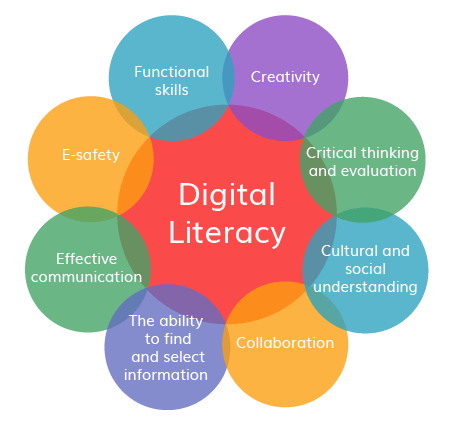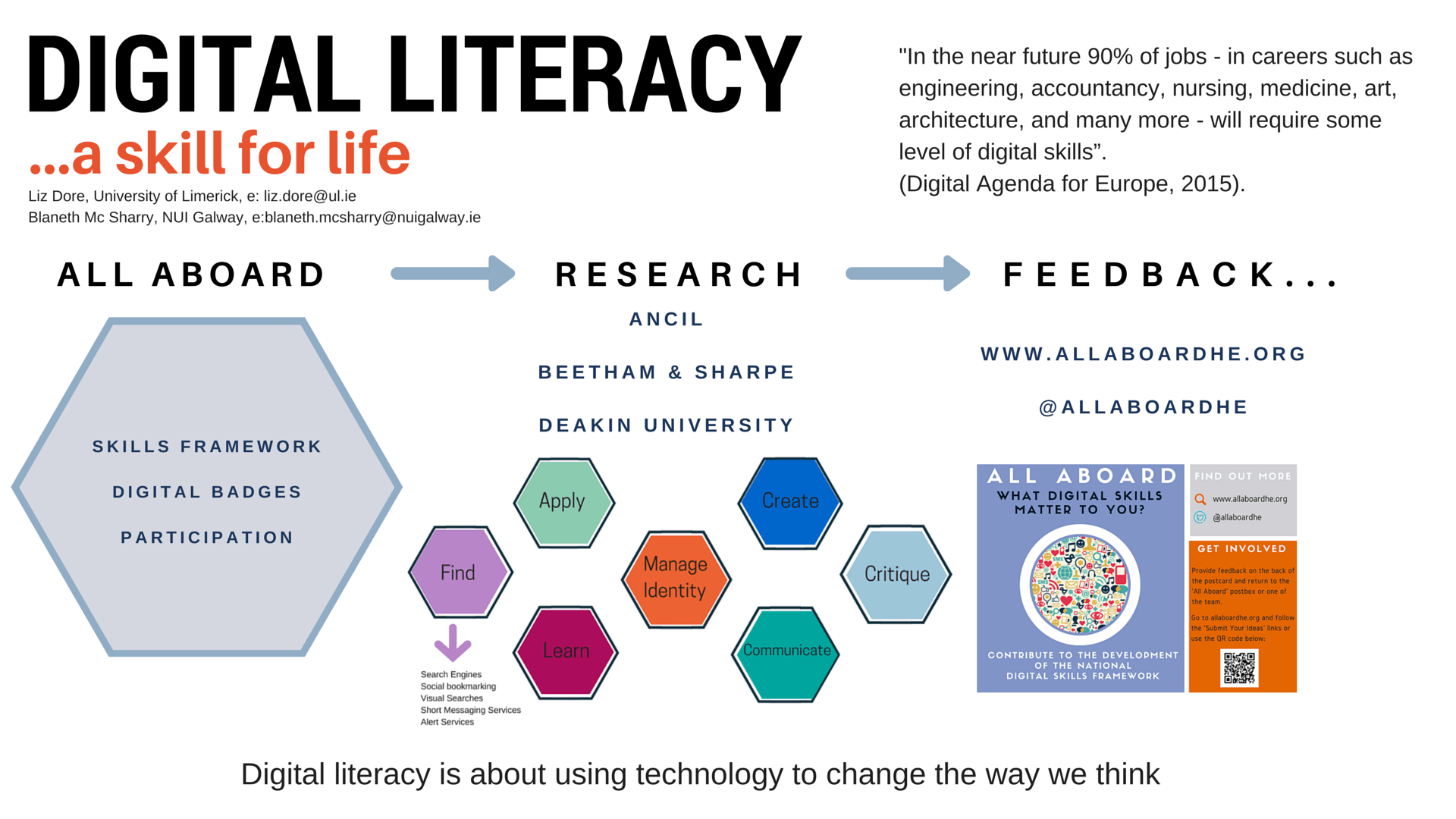Digital … Literacy … Divide

In considering the implications of mobile technology use within the realm of higher education, the question is not whether or not a digital divide exists but rather how to calibrate digital literacies across that divide. While students may enjoy access to resources that enable mobile learning, frequently they do not possess the skills necessary to utilize that technology in a manner that lends itself more to the effective facilitation of deep learning and less to the mere functionality of applications. As a community college instructor, one of the most common difficulties I experience with learners who are digital natives is their general ineptitude to incorporate WILD for authentic learning experiences. Digital experience alone cannot yield digital literacy; when students move beyond adroit mobile usage and venture into the richness of embedded experience, higher levels of information and digital literacy activate the greater breadth and depth of authentic engagement.
 Access to technology does not predicate user aptitude. “The definition of access,” Dolan asserts “now includes the accessibility of the locations of the technology, the availability of complementary technologies (such as software), the explosion of mobile technology, and the personal skills students possess to understand and use the technology. In addition, students’ access to technology at home and the ways they use technology outside of school appear to be disconnected to their access to, and use of, technology in school” (p.19). Very much akin to the diverse accessibility challenges seen in the K-12 student population, this sense of disconnection rings true in the community college sector of higher education as well, wherein many learners arrive on campus (or, as is the case in my environment, at a satellite center within a very low SES community) with technology and mobile access but staggeringly disparate skillsets. The divide, therefore, can be observed quite literally from one desk to the next within the same classroom irrespective of any administrative assumptions of homogeneity of digital literacy.
Access to technology does not predicate user aptitude. “The definition of access,” Dolan asserts “now includes the accessibility of the locations of the technology, the availability of complementary technologies (such as software), the explosion of mobile technology, and the personal skills students possess to understand and use the technology. In addition, students’ access to technology at home and the ways they use technology outside of school appear to be disconnected to their access to, and use of, technology in school” (p.19). Very much akin to the diverse accessibility challenges seen in the K-12 student population, this sense of disconnection rings true in the community college sector of higher education as well, wherein many learners arrive on campus (or, as is the case in my environment, at a satellite center within a very low SES community) with technology and mobile access but staggeringly disparate skillsets. The divide, therefore, can be observed quite literally from one desk to the next within the same classroom irrespective of any administrative assumptions of homogeneity of digital literacy.
 In a similar vein, Sharples identified a study wherein alumni graduate students’ usage of mobile technology for both personal and professional purposes existed as primarily “provisional” despite their assumed literacies: “Learning is increasingly intertwined with other everyday activities such as using a search engine to look up information or taking photos and sharing them instantly with others;” in examining these patterns of mobile usage, educators should be advised to implement a blend of perspectives which may entail “uncovering existing patterns of use and working within them, but also seeking to enlarge the scope of use of mobile devices” (p. 9). While this seems sound advice, solutions surrounding collective literacy remain aloof. “Cell phones and video games are consistently purchased over desktops among low SES individuals. These devices offer entertainment, connectedness, and status at relatively affordable prices. However, lack of computers, Internet, and productivity software makes schoolwork and job searching difficult to do from home. … An important factor … is that class is dynamic” (Yardi and Bruckman, p. 3048). Essentially, many learners are equipped with devices but unprepared to use them to scaffold higher learning endeavors.
In a similar vein, Sharples identified a study wherein alumni graduate students’ usage of mobile technology for both personal and professional purposes existed as primarily “provisional” despite their assumed literacies: “Learning is increasingly intertwined with other everyday activities such as using a search engine to look up information or taking photos and sharing them instantly with others;” in examining these patterns of mobile usage, educators should be advised to implement a blend of perspectives which may entail “uncovering existing patterns of use and working within them, but also seeking to enlarge the scope of use of mobile devices” (p. 9). While this seems sound advice, solutions surrounding collective literacy remain aloof. “Cell phones and video games are consistently purchased over desktops among low SES individuals. These devices offer entertainment, connectedness, and status at relatively affordable prices. However, lack of computers, Internet, and productivity software makes schoolwork and job searching difficult to do from home. … An important factor … is that class is dynamic” (Yardi and Bruckman, p. 3048). Essentially, many learners are equipped with devices but unprepared to use them to scaffold higher learning endeavors.
 Digital, information, and media literacies encompass essential 21st century skills required of all learners. Environmental challenges to the attainment of these literacies do not cease upon post-secondary matriculation. The most effective way to close the digital divide, in my opinion, is to begin closing the gap with literacy training initiatives at the college level that span pre-orientation through commencement.
Digital, information, and media literacies encompass essential 21st century skills required of all learners. Environmental challenges to the attainment of these literacies do not cease upon post-secondary matriculation. The most effective way to close the digital divide, in my opinion, is to begin closing the gap with literacy training initiatives at the college level that span pre-orientation through commencement.

Additional Resources:
All aboard. Empowering staff and students to flourish in the digital age
Digital Native Does Not Mean Digital Literate
How a 21st-Century Learning Environment Helps Students Master Tough Subjects
7 Reasons Why Digital Literacy is Important for Teachers
Socioeconomic Status and Higher Education Adjustment
Teaching in Higher Ed: Developing 21st Century Skills
What Is Information and Digital Literacy?

REFERENCES:
Dolan, J. E. (2016). Splicing the divide: A review of research on the evolving digital divide among K–12 students.
Sharples, M. (2013). Mobile learning: research, practice and challenges.
Yardi, S. and Bruckman, A. (2012). Income, race, and class: Exploring socioeconomic differences in family technology use.

Hi Crystal
First I would like to tell you that I highly appreciate your use of colors in your visuals. I also appreciate the structure of your presentation of the issues you identified and explored in your blog post that began with providing a background that contextualized your main point and then discussing relevant factors and ending it with a proposed solution.
I share your thoughts when you said that “digital experience alone cannot yield digital literacy” I believe that this is very true among the new generation of learners. Most of them are good at using technologies but do not engage in reflective learning about their interaction with digital content. From my own observation, they seem to be primarily concerned about the use of technology rather than what the technology can teach them.
And as you said “many learners are equipped with devices but unprepared to use them to scaffold higher learning endeavors.”
The potential solution which you offered through your statement that said: “the most effective way to close the digital divide, in my opinion, is to begin closing the gap with literacy training initiatives at the college level that span pre-orientation through commencement.”, made me reflect about the readiness of incoming college students to engage in digital literacy training especially when they are coming from third world countries where digital tools are accessible and affordable but the Internet service is not. As I have written in my blogpost, mobile devices are affordable in my country but good Internet service is not. This has led to the use of Internet cards that are sold on a per hour access basis.
So my question is, if we are to use literacy training as a means to address digital divide, can we achieve the desired outcome if the training does not necessarily involve the use of technology ? ( or as they often tell us before in school “just imagine how it works”).
Thanks for your post.
Ray
Students are using technology more than ever before, but they are using it to pursue their own self directed learning and learning goals. As you’ve mentioned, most students are using mobile technology for entertainment and playing games, which shows that there is at least the desire to engage with something that will hold a user’s attention.
As you’ve said the solution to increasing digital literacy remains aloof and from the readings, I think the lack of solution comes from three things: mobile technology (namely smartphones) are an emerging technology, we are still learning how they are impacting our society, our brains, and our developing youth, mobile research lacks large scale deployment, and there are very few studies on mobile vs traditional learning (Sharples 2013).
One of my primary interests is in using games to increase learning outcomes and engagement. Video games are looked at by many parents as a distraction from what students ought to be doing. There haven’t been many published studies and the ones that have been published are divided in how effective utilizing games in the classroom is. The things that students do in their personal time with mobile technology like social media is ruled as useless in an educational context. Combined with most students using the internet more outside of the classroom than in it has led to a “digital disconnect” that threatens to put teachers even more out of step with their students (Dolan 2016).
I say all this because I agree that we need to find ways of educating students entering college in digital literacy, and guide students on ways to treat the internet not just as a dopamine button or a means to shut off one’s brain, but to engage in deep learning/self-directed learning. As you’ve mentioned those in lower SES living situations are the ones most at risk at not gaining digital literacy, which will only compound as time goes on, leaving them less prepared to live in our 24/7 digitally connected world.
Great post and I look forward to reading again next week!